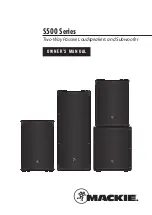
3
The performance of the Model Treo is com-
promised by a mono-wire connection. For op-
timum performance you should bi-wire the
speakers.
E
NHANCED
M
ONO-
W
IRE
C
ONNECTION
Mono-wiring should only be used with the Treo as a tem-
porary connection method. The speakers should be bi-wired
as soon as possible.
1. Cut two sections of insulated wire about 2½ inches
long to make two jumper wires. Crimp and solder
spade lugs to all four ends of the two jumper wires.
2. Connect one end of a jumper wire under the high -
frequency negative terminal screw and one end of the
other jumper wire under the high-frequency positive
terminal screw.
3. Crimp and solder spade lugs to the speaker ends of
the cable from the amplifier.
4. Connect the negative side of the speaker cable and the
jumpper cable from the high-frequency negative
terminal screw under the low-frequency negative
terminal screw.
5. Connect the posite side of the speaker cable and the
jumper cable from the high-frequency positive
terminal screw under the low-frequency positive
terminal screw.
6. Connect the speaker cables to your amplifier. Verify
proper polarity.
V
ERTICAL
B
I
- A
MP
C
ONNECTIONS
Amplifier
Terminal
V
ERTICAL
B
I
- A
MP
Caution: Some solid state amplifiers are not stable driv-
ing a capacitive load. Listen for high frequency oscillation
(brightness) and higher amplifier operating temperature.
We only recommend bi-amplification when every com-
ponent in the system is the best available and there is no
other path to improving the system, otherwise, you are bet-
ter off investing in the best single amplifier within your
budget rather than dividing your budget between two less
expensive, inferior sounding amplifiers.
Vertical Bi-amplification uses a stereo amplifier to drive
each speaker. Four identical runs of equal length speaker
cables are required (Two per speaker).
1. Connect two cables to each speaker as described in
steps 1-3 of the true bi-wire section on the previous
page.
2. Designate one stereo amplifier as the left channel am-
plifier and the other identical stereo amplifier as the
right channel amplifier.
3. Connect the preamp’s left channel output to both inputs
of the left amplifier using two sets of preamplifier out-
puts and two cables or one cable and a high quality sin-
gle female to dual male “Y” connector. Use the same
method to connect the preamplifier's right channel out-
put to both inputs of the right amplifier.
4. Connect the low-frequency cable from the left speaker
to one channel of the left amplifier. Connect the high-
frequency cable from the left speaker to the other chan-
nel of the same amplifier. Verify proper polarity.
5. Repeat step 4 for the right speaker and the right ampli-
fier.
Left Channel
Outputs
Right Channel
Outputs
Amplifier
M
ONO-
W
IRE






























